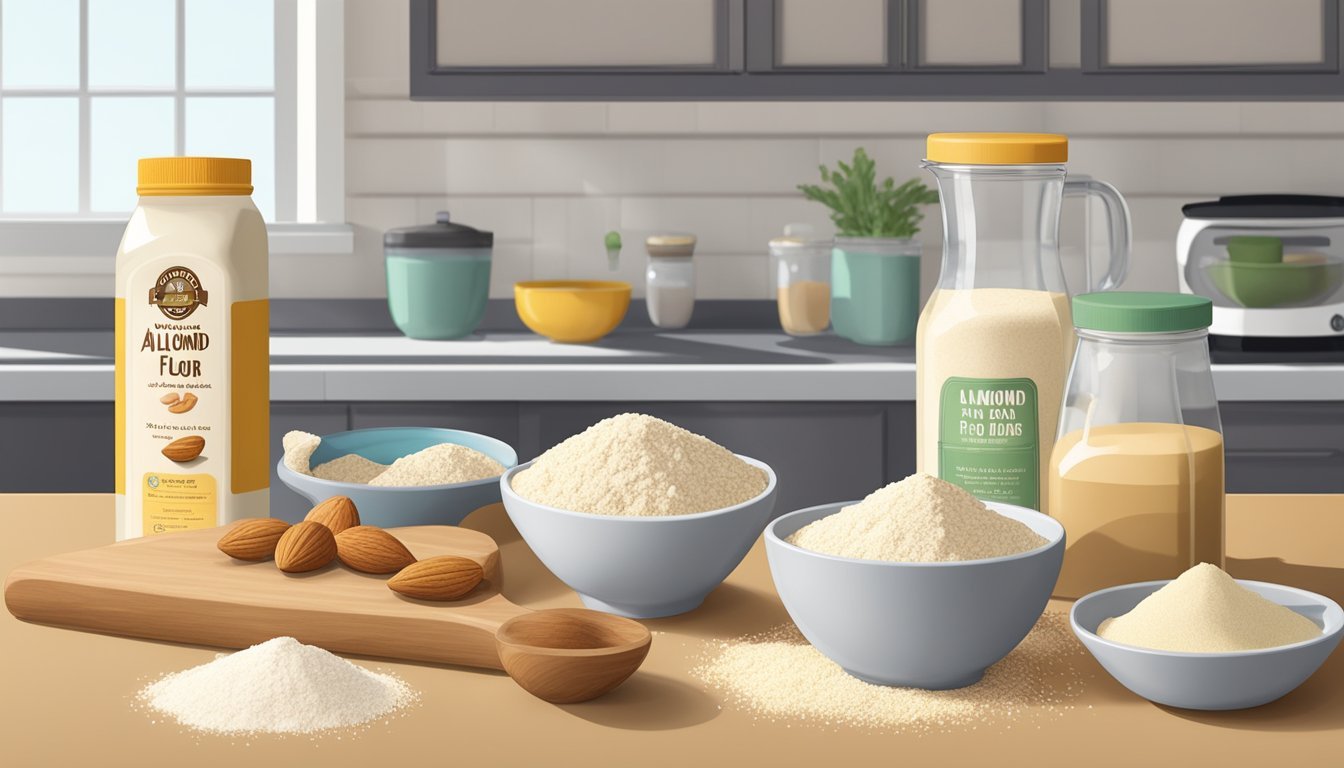Almond Flour Substitutes
Top Alternatives for Gluten-Free Baking
Almond flour has gained popularity as a staple in gluten-free, paleo, and keto baking due to its high content of healthy fats and versatility in recipes. Its fine texture and rich, nutty flavor make it a desirable ingredient for those looking to maintain these specific dietary lifestyles. As a gluten-free alternative to traditional wheat flour, almond flour offers a boon for people with gluten sensitivities or celiac disease, while also providing nutritional benefits such as protein, fiber, and vitamin E.
However, several reasons might lead bakers to seek substitutes for almond flour. Allergies to tree nuts or the need for a nut-free baking environment are common factors. Others might look for alternatives that are lower in fat or calories or that offer different flavors and textures in baked goods. Options such as oat flour can impart a distinctive nuttiness and light texture to cakes, while coconut flour offers a fruity and sweet flavor profile and is also rich in fiber and protein, maintaining the health-focused benefits of almond flour.
Substitutes like oat flour, coconut flour, and combinations of gluten-free flours such as tapioca and coconut flour can serve as effective replacements, ensuring that the dietary requirements are met without compromising the quality of the final product. These alternative flours are usually incorporated into recipes on a one-to-one basis, but slight adjustments might be required depending on the specific characteristics of the flour used. The flexibility of these substitutes allows for creative adaptations in recipes, ensuring that dietary needs and flavor preferences are addressed with confidence.
Understanding Almond Flour
Almond flour, made from finely ground almonds, is a staple in many kitchens for its flexibility and health benefits, especially within gluten-free and low-carb baking circles. It's well-regarded for its nutritional content and gentle impact on glycemic index levels.
Nutritional Profile of Almond Flour
Almond flour is rich in protein, fiber, and healthy fats. It provides an array of vitamins and minerals, particularly vitamin E, magnesium, and calcium. Here’s a brief snapshot of what one can typically expect from a quarter-cup serving of this flour:
Protein: 6 grams
Fiber: 3 grams
Fat: 14 grams (mostly unsaturated)
Vitamin E: 35% of the Daily Value
Magnesium: 19% of the Daily Value
Calcium: 6% of the Daily Value
Benefits in Gluten-Free and Low-Carb Baking
For individuals following a gluten-free or low-carb diet, such as keto or paleo, almond flour is an excellent choice. It allows those with gluten intolerance to enjoy a variety of baked goods without the gastrointestinal discomfort that can come from traditional wheat flours. Its low carbohydrate content also makes it desirable for keto dieters aiming to restrict their carb intake.
Common Uses in Baking and Cooking
In the kitchen, almond flour is versatile. It can be used as a one-to-one substitute in recipes calling for breadcrumbs or for giving a tender crumb to baked goods like cookies and cakes. It's also the go-to flour for gluten-free pie crusts and serves as an apt coating for breading in savory dishes. However, when baking with almond flour, bakers often make adjustments to account for its higher moisture content compared to wheat flour.
Challenges of Almond Flour Substitution
When substituting almond flour, one must consider various factors such as texture, flavor, nutritional content, and the potential for allergic reactions to ensure the resulting dish meets the desired quality and dietary needs.
Texture and Flavor Consideration in Substitutes
Almond flour has a unique texture and flavor that can be difficult to replicate with substitutes. Often, alternatives may change the consistency of baked goods, leading to a crumbly texture or a dense composition. For example, coconut flour, while similar in health attributes to almond flour, is highly absorbent and can result in a drier final product. It requires additional liquid or binding agents to mimic the characteristics of almond flour. Cashew flour or macadamia nut flour can provide a similar nutty flavor, but the latter's bolder taste may alter the flavor profile of the intended recipe.
Impact on Nutrition and Diet
Almond flour is known for its low carbohydrate content and healthy fats, making it a favorite for those on gluten-free or keto diets. Substitutes can have varying nutritional profiles with differing levels of carbohydrates, fats, and fiber. For instance, oat flour offers a high fiber content and a distinctive nutty flavor, making it a beneficial substitute for those not adhering to a low-carb diet. However, it contains more carbohydrates than almond flour. Nutrition-conscious individuals should assess the nutrient composition to align with their dietary restrictions or health goals.
Allergic Reactions and Nut-Free Alternatives
Nut allergies can pose a significant challenge in using almond flour. To accommodate those with such allergies, nut-free alternatives must be considered. Pumpkin seed meal and sunflower seed flour serve as nut-free and gluten-free options that can replace almond flour on a one-to-one basis, although each brings its own distinct flavor. Flaxseed meal, rich in Omega-3 fatty acids, can also be used in certain recipes but may require different preparations to avoid a gritty texture. These alternatives ensure that individuals with nut allergies can still enjoy baked goods without compromising on taste or texture while adhering to their allergic constraints and dietary restrictions.
Popular Almond Flour Substitutes
When baking or cooking, various alternatives to almond flour can be employed, each offering distinct qualities. Whether catering to gluten-free requirements or simply seeking variety, there is an array of substitutes to choose from.
Coconut Flour for Gluten-Free Options
Coconut flour is prevalent for those who adhere to gluten-free dietary needs. It is a gluten-free flour that brings a slight sweetness and rich fiber content to recipes. Its absorbent nature means that it requires an increased number of eggs or other wet ingredients to maintain moisture.
Fiber Content: High
Texture: Very absorbent
Usage: Best used with additional liquids
Wheat-Based Flours for Non-Gluten Restrictions
For individuals without gluten sensitivities, wheat-based flours like all-purpose flour, whole wheat flour, and white flour serve as versatile substitutes for almond flour. They are not gluten-free but can typically be used in a 1:1 ratio in recipes.
All-Purpose Flour
Gluten Content: Contains gluten
Texture: Less dense
Usage: Direct 1:1 substitution possible
Whole Wheat/White Flour
Gluten Content: Contains gluten
Texture: Denser, more robust flavor
Usage: May require adjustments for texture
Nut-Based Alternatives
Other nut flours like hazelnut flour, cashew flour, and macadamia flour offer flavors unique to each nut type and can be substituted on a 1:1 basis depending on the recipe. They provide similar textures and are also excellent for those looking for grain-free options.
Flavor: Rich, nutty
Texture: Similar to almond flour
Cashew Flour
Flavor: Mild, sweet
Texture: Fine, works well in bakes
Macadamia Flour
Flavor: Buttery, luxurious
Texture: Dense, good for cookies and pastries
Non-Nut Flour Alternatives
For individuals seeking alternatives to almond flour that are not derived from nuts, there are several options. These include flours and meals made from seeds, grains, and starchy tubers, which can cater to varying dietary needs such as gluten-free and low-carb diets.
Seed Flours and Meals
Flaxseed: A gluten-free option rich in fiber and omega-3 fatty acids, flaxseed meal works well in recipes, offering a slightly nutty flavor. It is also lower in carbs compared to traditional wheat flour.
Pumpkin Seed Meal: Another gluten-free alternative, pumpkin seed meal can be used on a cup-for-cup basis with almond flour and is high in minerals.
Sunflower Seed Flour: This is yet another seed-based, nut-free substitute, providing a mild, nutty flavor and a good amount of fiber.
Grain-Based Flours
Oat Flour: Made by grinding oats, this flour is rich in fiber and provides a light nuttiness to baked goods. It's a suitable choice for those avoiding nuts, but it is not always gluten-free unless specified on the packaging.
Rice Flour: Often used in gluten-free baking, rice flour is a mild-flavored option that can replace almond flour. It is also a good source of fiber but higher in carbohydrates.
Starchy Flours and Tubers
Tapioca Flour: Extracted from the cassava root, tapioca flour is a starchy, gluten-free flour that can help achieve a chewy texture in baked items.
Cassava Flour: Also from the cassava root, this flour has a neutral flavor and is gluten-free, grain-free, and nut-free, suitable for those on a paleo diet.
Potato Starch: While not a direct substitute for almond flour, potato starch can be used in conjunction with other gluten-free flours to add moisture to baked goods.
Using these substitutes, individuals with nut allergies or those following specific dietary guidelines can find suitable alternatives to almond flour without compromising on taste or texture.
Other Special Purpose Flours
With an increasing number of dietary preferences and restrictions, many consumers are turning to special purpose flours that cater to specific nutritional needs or cooking properties. These flours often provide unique benefits such as being gluten-free, rich in fiber, or aligned with paleo dietary guidelines.
Legume-Based Flour
Chickpea Flour: This gluten-free flour, also known as besan or gram flour, is derived from ground chickpeas. High in protein and fiber, chickpea flour is a staple in many cultures and suitable for gluten-free and paleo diets.
Fruit-Based Flours
Banana Flour: Made from green bananas, this flour is a rich source of resistant starch, promoting digestive health. It is gluten-free and paleo-friendly. Apple Flour: Produced from dried apples, apple flour adds a subtle sweetness and fiber to recipes. It's gluten-free and can be used to enhance the flavor of baked goods.
Other Grain-Free and Paleo Options
Plantain Flour: Similar to banana flour, plantain flour is made from dried, ground plantains. It's a grain-free, paleo option that is also gluten-free. Linseed (Flaxseed) Flour: With a high content of Omega-3 fatty acids and fiber, linseed flour is another excellent gluten-free substitute that fits within paleo dietary guidelines.
Creating Homemade Gluten-Free Flour Blends
Creating a successful homemade gluten-free flour blend requires an understanding of how different ingredients work together. The goal is to mimic the texture and functionality of traditional wheat flour while maintaining a favorable nutritional profile.
Blending for Desired Consistency and Taste
When preparing a gluten-free flour blend, they aim to achieve the consistency similar to wheat flour. It typically involves a combination of various gluten-free flours and starches. For instance:
Rice flour acts as a base, providing a neutral flavor and a fine texture.
Potato starch contributes to the lightness, often enhancing the fluffiness of baked goods.
Tapioca starch adds a chewy texture and helps in browning.
Xanthan gum is a common binding agent that replaces gluten. It helps to hold the structure of baked items together, so they don't crumble.
Here is a simple table outlining a basic blend ratio:
Ingredient Quantity (Cups) Purpose Rice Flour 2 Base flour Potato Starch ⅔ Lightness and Volume Tapioca Starch ⅓ Chewiness and Browning Xanthan Gum 1 tsp Binding and Structure
This blend can be adjusted according to taste preference or specific recipe requirements.
Considering Nutritional Value in Blends
Selecting ingredients for a gluten-free flour blend should also consider the nutritional value they bring to the table. Flour substitutes can vary widely in their fiber and mineral content:
Rice flour is generally low in fiber but can be replaced with brown rice flour for an added fiber boost.
Nut flours, like almond or hazelnut, introduce healthy fats, fiber, and minerals, enhancing the nutritional profile.
Coconut flour is high in fiber though it's very absorbent and needs more liquid in recipes.
Legume flours offer protein and fiber but can impart a strong flavor.
A blend that balances these various aspects can provide not just the right texture but also contribute to the dietary fiber and minerals required for a healthy diet. It's important to note how each ingredient affects the overall nutrient density.
Baking Considerations with Substitutes
When choosing a substitute for almond flour in baking, bakers must consider how ingredient variations will affect the final product’s texture, flavor, and consistency.
Adjustments in Recipe Ingredients and Ratios
Texture: Many alternative flours have a different grain size and absorbency than almond flour. For example, coconut flour is more absorbent and generally requires an increased number of eggs or other liquid ingredients to maintain moisture.
Almond Flour Substitute Texture Consideration Ratio 1 cup 1/4 cup Coconut Flour Finer, require more eggs 1:4 1 cup 1 cup Sunflower Seed Flour Similar, slightly coarser 1:1
Flavor: Nut flours like cashew or macadamia can be used in a 1:1 ratio but will impart their own distinct flavors which may or may not complement the desired taste profile of the baked good.
Understanding the Role of Fats and Binders
Fats: Almond flour has a high fat content, primarily monounsaturated fats. When using a flour with lower fat content, such as sunflower seed flour, the baker may need to increase fats like butter or saturated fat to achieve a similar richness.
Binders: Due to the lack of gluten, egg replacements or binders like cream of tartar may be necessary to provide structure to the recipe. Egg replacements may include apple sauce, mashed bananas, or commercial egg replacers.
Hydration and Leavening: The incorporation of baking powder can aid in leavening, especially important in gluten-free baking. Additionally, adjustments to hydration levels are key, as flours like coconut flour significantly increase the need for liquid ingredients.
Health Considerations and Dietary Impacts
Choosing almond flour substitutes requires considering their impact on health aspects such as blood sugar regulation, heart health, and weight management. Each flour alternative brings its own nutritional profile, affecting these areas differently.
Effect on Diabetes and Blood Sugar Control
Almond flour is known for its low glycemic index, meaning it has a minimal impact on blood sugar levels, an important consideration for individuals managing diabetes. Nut flours like walnut or hazelnut flour are also low in carbohydrates and may have similar effects. Oat flour, while higher in carbs, provides fiber which can help regulate blood sugar. Substitutes such as coconut flour, also are low-carb and gluten-free, but portions should be adjusted as it is more absorbent and denser than almond flour.
Heart Health and Cholesterol Management
Almond flour is rich in healthy fats including omega-3 fatty acids, beneficial for heart health and cholesterol management. Substitutes like flaxseed flour also offer these heart-healthy fats. Nut flours generally maintain a balance of monounsaturated and polyunsaturated fats, potentially aiding in lowering LDL cholesterol and thus reducing the risk of cardiovascular disease.
Weight Management and Satiety Levels
When it comes to weight management, almond flour's high protein and fiber content contribute to a feeling of fullness, aiding in appetite control. Flours with similar nutrient profiles, such as nut flours or flaxseed flour, can also promote satiety and may be lower in calories, helping maintain weight management goals. However, some substitutes might be denser in calories, which should be balanced against their ability to increase fullness.





